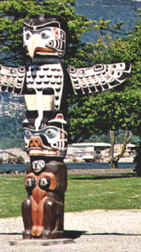|
|
In 1792, Captain George came to Pacific Northwest region to search Northwest Passage. He mapped and surveyed the area that is now downtown Vancouver, giving various parts British names. He returned to his native England little imagining that is less than one hundred years his name would be immortalized in that rugged wilderness.
Sixteen years later, following the course of the river that today bears his name, Simon Fraser arrived in what is now Marpole. He was searching for Columbia River and have determined that this was not Columbia and confronted by hostile Indians, he turned back in disappointment the same day. However, the area was opened by these overland explorations and the arrival of Hudson's Bay Company and later the gold rush, began the influx of white men and the beginning of permanent settlement.
For approximately the next sixty years, the Western part of Burrard Inlet was largely ignored. Granville, as it was known, was little more than an appendage to New Westminster and seemed destined to remain so. Settlements grew mainly to the East in Fort Langley and New Westminster, until about the mid 1860s, when the lumber mills at Granville with their thirsty worker, caught the eye of "Gassy" Jack Deighton. He set up saloon in what is know as Gastown. At this time as well, John Martin, William Hailstone and Samuel Brighouse pre-empted 550 acres of land adjoining Burrard Inlet. For their audacity in staking land so far from the center of things, they were laughingly dubbed "Three Greenhornes". Today, that land comprises the whole of Vancouver's West End.
With the coming of railroad, the importance of Granville was ensured and in 1886, it was incorporated as city of Vancouver. Almost immediately it was razed by fire and the city fathers, undaunted, set up city hall in a tent. It was at this time that the land that is Stanley Park was set aside for public use, an act for which Vancouverites and visitors alike must be eternally grateful.
Railroad was finally completed in 1887, bringing a boom of expansion and the most precious commodity of all-immigrants. Today, the large variety of ethnic background in Vancouver adds immeasurably to the atmosphere of the city and is evidenced in the fine array of restaurants and the many important stores.
Shipping increased to meet the railroad and Vancouver soon became Canada's main West coast seaport. Although Vancouver is about one hundred years old, an infant among the world's cities, this mood of expansion has continued, until today Greater Vancouver area is made up of Vancouver, Burnaby, New Westminster, West Vancouver, Port Moody, Richmond, Coquitlam, Port Coquitlam, Surrey, White Rock and Delta. This area make it the third largest city in Canada, after Toronto and Montreal. Furs and gold no longer motivate people to come to Vancouver, but development continues at a rapid pace. As well as being great seaport, Vancouver is a center for the ever-expanding industries of British Columbia and continues to attract growing numbers of tourists.
Today the sea forms an integral part of life in Vancouver. Ocean-going freighters dock here, carrying goods to and from all parts of Canada. The mouth of Fraser is host to much of the coast fishing fleet and the many docks and marinas attest to the popularity of recreational boating.
The pioneering spirit, which carved a metropolis from the wilderness exists today in the mood of bustling prosperity evident in Vancouver. This in combination with mild climate and beautiful natural setting make Vancouver one of the most areas in Canada for residents and tourists alike.

|
|

